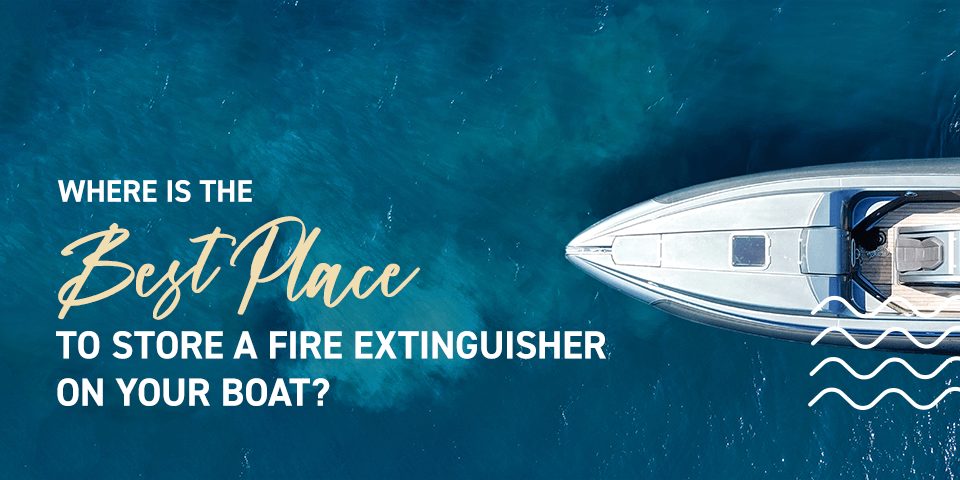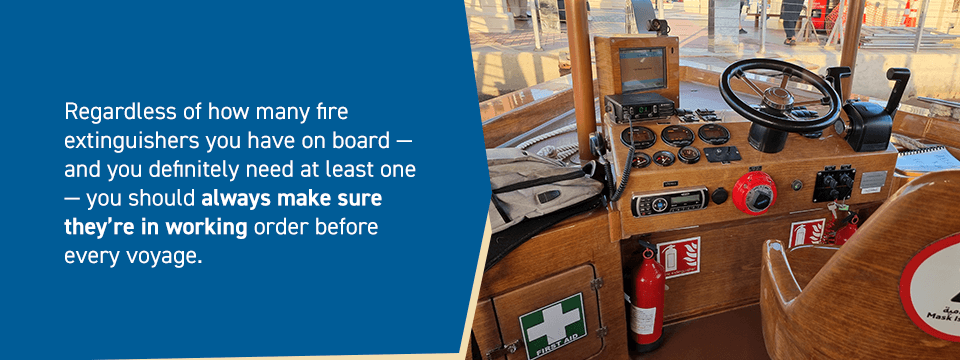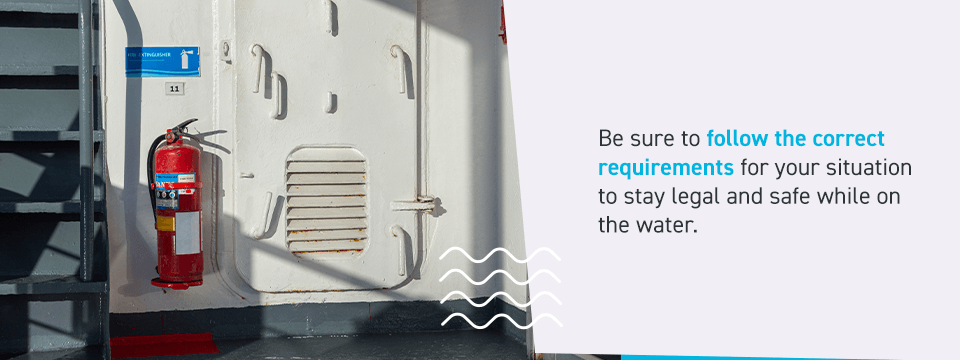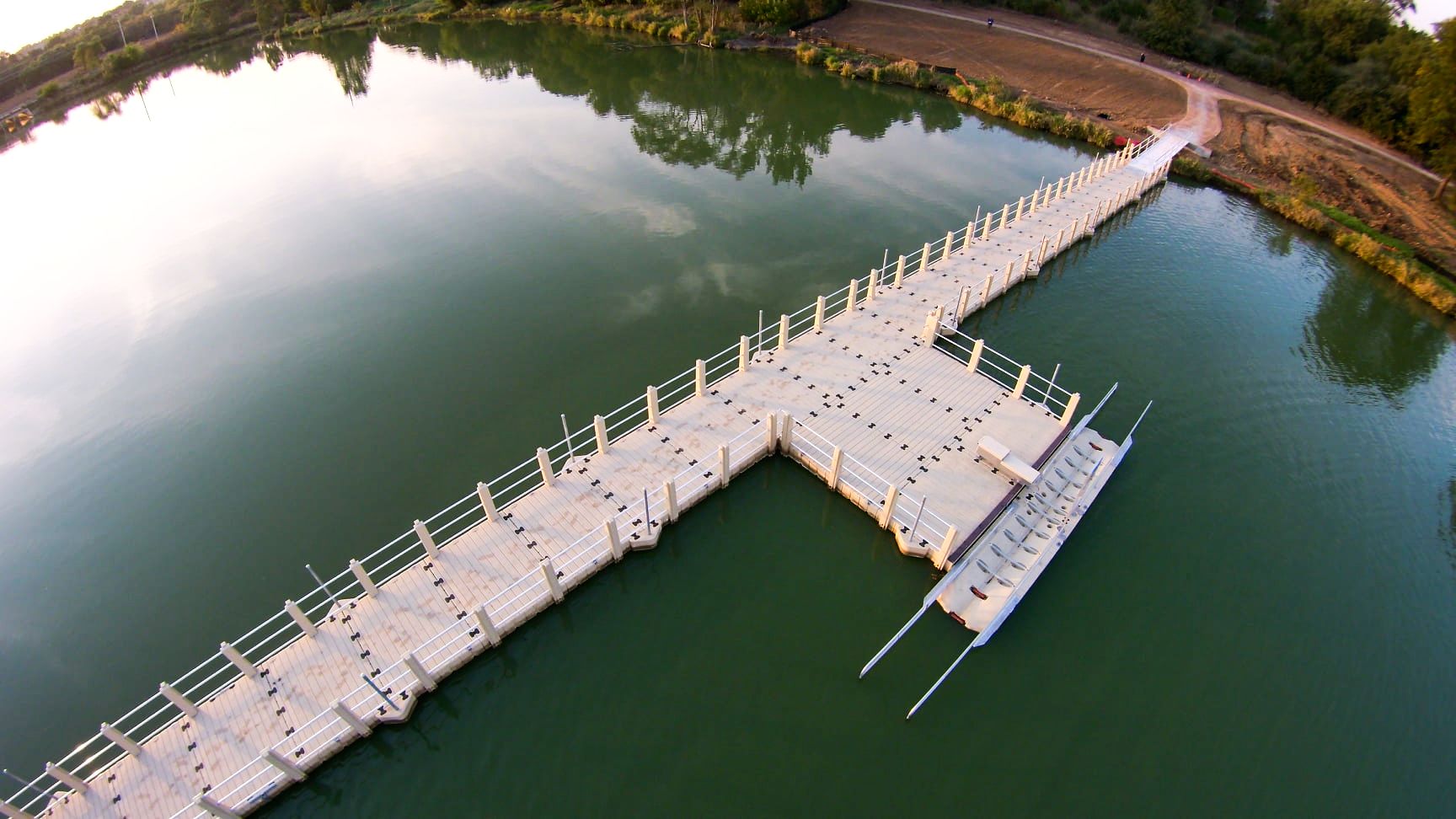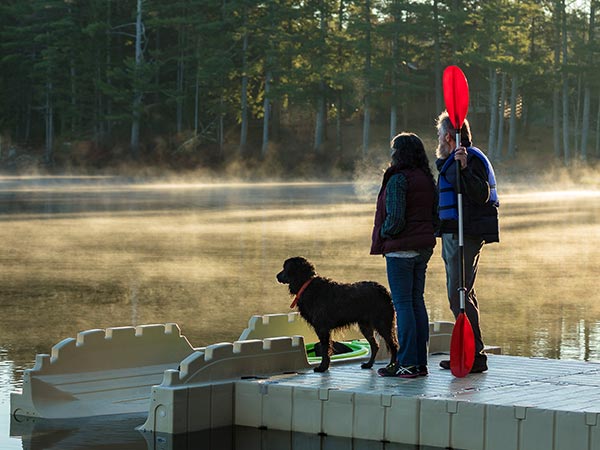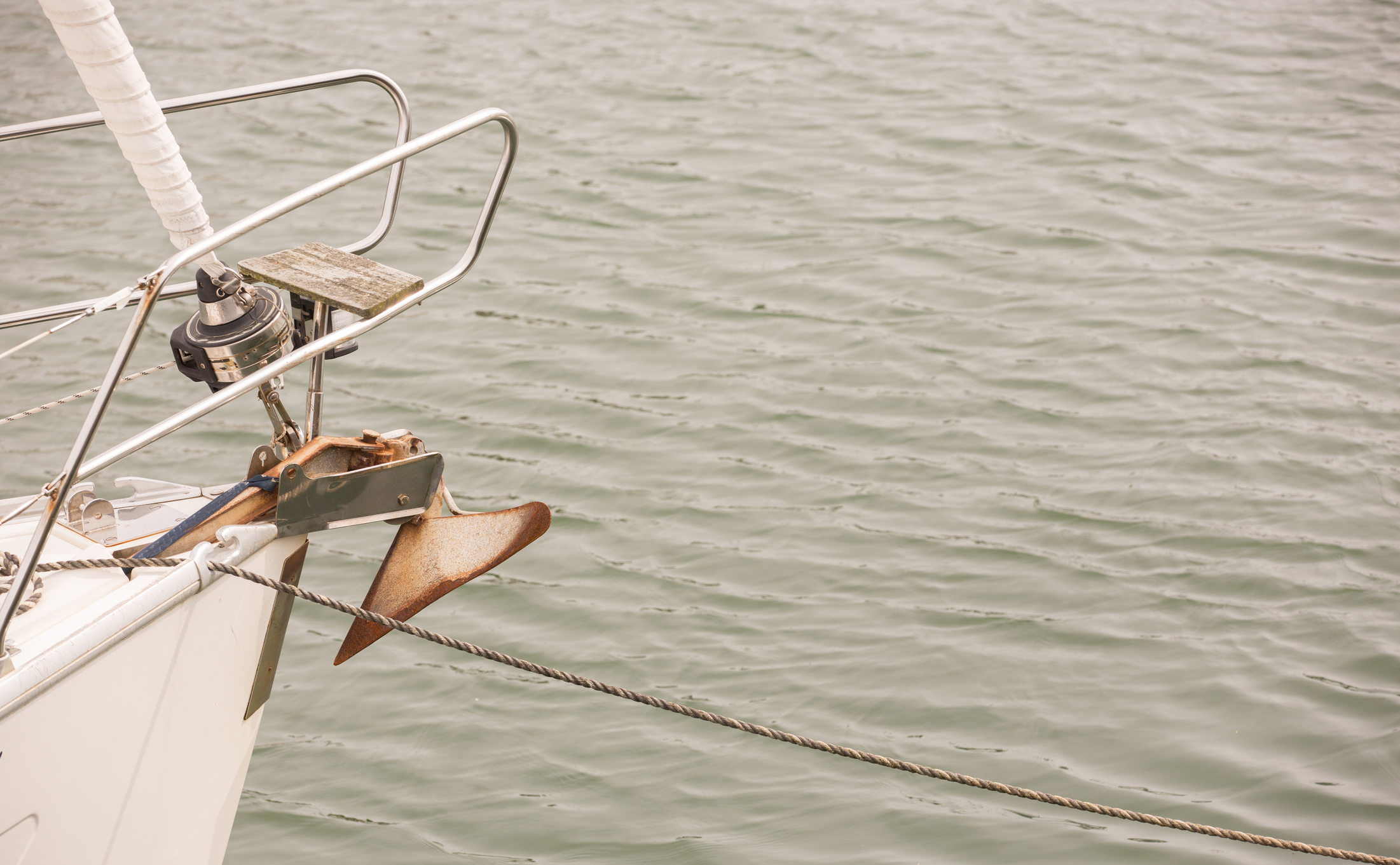Filters
Where Is the Best Place to Store a Fire Extinguisher on Your Boat?
When you are having fun on your boat with friends and family, accidents can happen at any time. That’s why a boat fire extinguisher should be a staple in your emergency kit.
Having a boat fire extinguisher on hand — and knowing how to use it properly — is essential for keeping yourself, your loved ones and your boat safe from fire damage. This article goes over the importance of having a boat fire extinguisher, where to keep it on your boat, essential fire extinguisher requirements and how to use your fire extinguisher. It also answers some of the most common questions people ask about boat fire extinguishers.
Read the full article or jump to a specific section:
- Why Have a Boat Fire Extinguisher?
- The Best Location for Fire Extinguishers
- Marine Fire Extinguisher Requirements
- How to Use Your Fire Extinguisher
- Boat Fire Extinguisher FAQs
- Check Out Our On-Dock Storage for Fire Extinguishers Today
Why Have a Boat Fire Extinguisher?
A boat is at a greater risk of fire due to factors such as enclosed living spaces, the engine, double bottoms that aren’t sealed to the hull and heavy fuel tanks. From kitchen fires to flammable liquid leaks, having a fire extinguisher handy ensures you and your passengers stay safe and are prepared for unexpected accidents while you’re out on the water. Depending on the type and size of your boat, you may even be required by law to have at least one on board.
The Best Location for Fire Extinguishers
Investing in one or two fire extinguishers is the first step to ensuring everyone on your boat stays safe. It’s also important to store them in the right location. Here are some of the most important considerations regarding the best place to put a fire extinguisher on your boat:
- Put the fire extinguisher where people spend time: You want to ensure your fire extinguisher is readily accessible in emergencies. A fire extinguisher is only useful if people can easily reach it when the moment comes, so consider placing it in high-traffic areas of your boat. Doing this ensures that anyone who happens to be closest to the fire extinguisher can grab it when needed, rather than only having one person onboard who knows where the fire extinguisher is at any given time.
- Put the fire extinguisher in fire-prone areas: Besides keeping your boat’s fire extinguishers in high-traffic areas, you should have them in rooms where a fire would be more likely to occur, such as the kitchen, bilge, cabin and hull. Consider other danger zones, such as the area where you store gasoline or other flammable liquid. Keeping a fire extinguisher in these areas makes sense because they are the most fire-prone areas. Should a fire break out, you’ll be ready to respond.
- Be sure to mount the fire extinguisher properly: Once you’ve determined the best locations to store your fire extinguishers, make sure you are properly mounting the fire extinguisher in your boat. Verify nothing blocks your access to the fire extinguisher, as every second is crucial when dealing with a fire on your boat. To prevent the chemicals in your fire extinguisher from settling at the bottom of the canister, mount and store each fire extinguisher at an angle. This ensures they are ready for use at a moment’s notice, even after an extended period without use.
Additional Considerations About Marine Fire Extinguisher Placement
If you’re still unsure where exactly to put your marine fire extinguishers on your boat, answer these questions about your vessel to determine the best places to keep them and how many you might need:
- Where is the gas tank?
- Is the boat cleaned often?
- Do some areas of the boat regularly contain trash or debris?
- Where do people gather when using your boat?
- If there is a kitchen onboard, where is it?
- Is the kitchen kept clean consistently?
- Where do you keep flammable liquids onboard?
Regardless of how many fire extinguishers you have on board — and you definitely need at least one — you should always make sure they’re in working order before every voyage. Check the tank’s expiration date and regularly test for functionality. Taking these actions consistently is a crucial step in boat fire preparedness.
Marine Fire Extinguisher Requirements
The U.S. Coast Guard has set forth several marine fire extinguisher requirements that vary based on your boat’s size. This section covers some of the main requirements for marine fire extinguishers that you should know about. But first, you need to know about the different types of fire extinguishers to ensure you’re getting the right ones for your boat.
Fire extinguishers come in several classes denoted by a letter of the alphabet. Here’s a quick breakdown of the different classes:
- Class A (Ash): Class A fire extinguishers are for ordinary combustible materials like trash, fabric and wood. These extinguishers use water or foam to put out fires.
- Class B (Barrel): Class B fire extinguishers are for flammable liquids like petroleum, gasoline, paint and oil. These extinguishers use dry chemicals in the form of powder or foam to extinguish fires. These are the kind of fire extinguishers you need on your boat according to Marine and Coast Guard fire extinguisher requirements.
- Class C (Current): Class C fire extinguishers are for electrical fires. They put out fires using carbon dioxide or dry chemicals.
- Class D (Dynamite): Class D fire extinguishers are for fires that involve burning metals, usually titanium and magnesium. These extinguishers put out fires using dry chemicals.
- Class K (Kitchen): Class K fire extinguishers are for kitchen-related fires involving grease, animal fats, vegetable fats and other cooking oils. Class K fire extinguishers are technically a part of Class B extinguishers, so you should consider having one onboard if you have a kitchen or cook on deck.
Additionally, certain boat features require you to have at least one B-1 fire extinguisher onboard:
- Length of 26 feet or less
- Enclosed compartment for the fuel tank
- Unfilled double bottom
- Enclosed living spaces
- Inboard engine
- Permanently installed fuel tanks
Some boat features require you to have more than one fire extinguisher onboard. Here is a closer look:
- If you have a boat anywhere from 26 to 40 feet, you need two B-1 extinguishers or one B-2 type on board.
- Larger boats, such as those 40 to 65 feet, must have either three B-1 or a combination of one B-1 and one B-2 extinguisher.
- All boats over 65 feet need anywhere from one to eight B-2 fire extinguishers.
Keep in mind these are the minimum amounts — you can always have more fire extinguishers, especially in areas with a higher risk of fire. Failing to follow these marine fire extinguisher requirements could subject you to a hefty fine. In worst-case scenarios, you could even lose your boating license. Be sure to follow the correct requirements for your situation to stay legal and safe while on the water.
How to Use Your Fire Extinguisher
Now that you know more about some of the main requirements for fire extinguishers on a boat, you need to know how to use them in an emergency. Ideally, you never have to use your boat fire extinguisher, but preparing yourself beforehand could be critical in saving someone’s life should a fire ever combust on your boat.
Here are the four steps to using a fire extinguisher:
- Pull the fire extinguisher pin, which is located near the top of the canister.
- Aim the nozzle or hose toward the bottom of the fire while standing at the safest distance possible. The fire extinguisher should have an operational guide that gives more information about safe distances and aiming.
- Squeeze the operating lever to eject the contents of the fire extinguisher toward the fire.
- Sweep the nozzle or hose from side to side to achieve full coverage until the fire ceases.
Boat Fire Extinguisher FAQs
There’s always more to learn about boating safety, especially regarding fire extinguishers. Here are some frequently asked questions and answers that can help you take your next step with confidence:
- How do I tell if my fire extinguisher is expired? Your fire extinguisher is expired if it is 12 years past the stamped date.
- How do I know if my fire extinguisher is approved for use on boats? The label should read “Marine Type — USCG Approved” for it to be acceptable for use on boats.
- Are there any exemptions to the requirement to have a fire extinguisher onboard a motorized vessel? Yes. If your motorized boat is less than 26 feet long, has an outboard engine, uses a portable fuel tank and has zero areas that can trap fuel vapors, then the boat is exempt from needing a fire extinguisher.
- What do I do if the fire extinguisher gauge is in the red? If your fire extinguisher is disposable with a gauge in the red, you must discard and replace it. If your fire extinguisher is rechargeable with a gauge in the red, you must get it serviced and tagged before reuse.
- What’s the difference between non-rechargeable and rechargeable fire extinguishers? Non-rechargeable fire extinguishers are only functional for a single use, while a rechargeable fire extinguisher can be recharged and used again.
- Do I have to throw away an expired fire extinguisher? You are not required to throw away an expired fire extinguisher, but you will be required to supplement it with a fire extinguisher that meets all requirements and is not expired.
Check out Our On-Dock Storage for Fire Extinguishers Today
Along with our selection of floating docks, EZ Dock offers a variety of accessories to meet your needs this boating season. Our corner storage box, which is also available in connection boxes, offers a convenient, safe space to store your boating supplies.
Check out our compact on-dock storage solutions, and contact us online to find out more.

